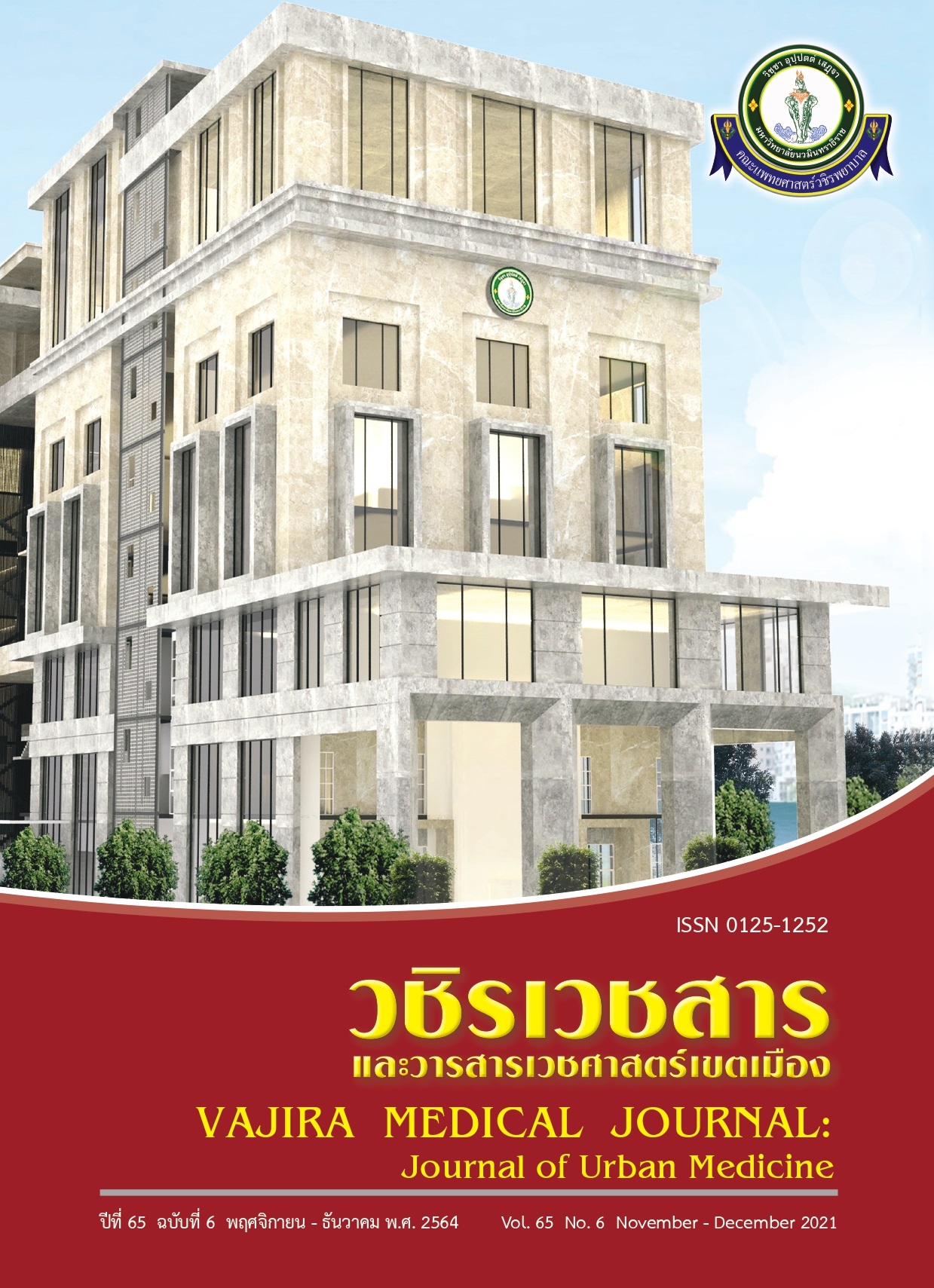Accuracy of Fine Needle Aspiration Cytology of Thyroid Lesions: An 8-year Experience in Urban-based Tertiary Medical Center in Bangkok, Thailand
Main Article Content
Abstract
Background: The Bethesda system for reporting thyroid cytopathology (TBSRTC) is a standardized and reproducible system. It is used worldwide to interpret fine-needle aspiration cytology (FNAC) of thyroid. A crucial issue of thyroid FNA is its accuracy comparing with the final histologic outcomes. This may vary on many factors e.g., nature of lesion, quality of the cytologic specimen, pathologist’s experience, etc.
Aim: To evaluate the accuracy of TBSRTC from FNAC. Nature of lesion which may impact the accuracy was also studied.
Method: A retrospective study evaluating data of TBSRTC in our hospital during January 2013 to June 2021 were reviewed and compared to its final histologic outcomes to determine diagnostic accuracy.
Results: 3714 FNA procedures were done at Vajira Hospital from January 2013 to June 2021, consisting of 3,266 (87.94%) females and 448 (12.06%) males. The female: male incidence ratio was approximately 7:1. The age at diagnosis was ranged from 14 to 86 years (median 53 years). A total of 527 patients (461 female; 87.5%, and 66 male; 12.5%) underwent surgical resection with available histopathology evaluation. From those cases, the FNAC reports revealed 172 (32.6%) cases as non-diagnostic/unsatisfactory (ND/US), 216 (41.0%) cases as benign, 87 (16.5%) cases as atypical of undetermined significant or follicular lesion of undetermined significance (AUS/FLUS), 4 (0.8%) cases as follicular neoplasm or suspicious for follicular neoplasm (FN/SFN), 36 (6.8%) cases as suspicious for malignancy (SM), and 12 (2.3%) cases as malignant. The risk of malignancy (ROM) in operated thyroid specimen was 15.7%, 15.3%, 33.3%, 0%, 91.7%, and 91.7%, respectively
Conclusions: The accuracy of thyroid FNAC at our hospital was high in malignant groups including category V and VI. However, the ROM in categories I, II, III, and V exceeded the suggested limit in TBSRTC. We strongly encourage medical practitioners in all professions to use TBSRTC because it is an international standard that shares a common understanding and helps guide patient management.
Downloads
Article Details
References
Thyroid Nodules [Internet]. Alexandria: American Thyroid Association;c2021 [cited 2021Jun10]. Available from: https://www.thyroid.org/thyroidnodules/
Cancer Today [Internet]. Lyon: International Agency for Research on Cancer ;c2021 [cited 2021Jun10]. Available from: https://gco.iarc.fr/today/fact-sheets-cancers
Baloch ZW, Cooper DS, Gharib H, Alexander EK. Overview of Diagnostic Terminology and Reporting. In: Ali S, Cibas E, editor. The Bethesda System for Reporting Thyroid Cytopathology. 2nd ed. Cham, Switzerland: Springer International Publishing; 2018. p.1-6. doi: 10.1007/978-3-319-60570-8_1
Anand B, Ramdas A, Ambroise MM, Kumar NP. The Bethesda System for Reporting Thyroid Cytopathology: A Cytohistological Study. J Thyroid Res 2020;2020:8095378. doi: 10.1155/2020/8095378.
Yaprak Bayrak B, Eruyar AT. Malignancy rates for Bethesda III and IV thyroid nodules: a retrospective study of the correlation between fine-needle aspiration cytology and histopathology. BMC Endocr Disord 2020;20:48. doi: 10.1186/s12902-020-0530-9.
Thewjitcharoen Y, Butadej S, Nakasatien S, Chotwanvirat P, Porramatikul S, Krittiyawong S, et al. Incidence and malignancy rates classified by The Bethesda System for Reporting Thyroid Cytopathology (TBSRTC) - An 8-year tertiary center experience in Thailand. J Clin Transl Endocrinol 2018;16:100175. doi: 10.1016/j.jcte.2018.12.004.
Abdullah N, Hajeer M, Abudalu L, Sughayer M. Correlation study of thyroid nodule cytopathology and histopathology at two institutions in Jordan. Cytojournal 2018;15:24. doi: 10.4103/cytojournal.cytojournal_53_17.
Shrivastava P, Meenai FJ. Application of bethesda reporting system of thyroid cytology and its clinical significance. Saudi J Pathol Microbiol 2020;5(5):263–70. doi: 10.36348/sjpm.2020.v05i05.007
Jeelani T, Rafiq D, Nazir W, Shafi Y, Bashir N, Charak A, et al. Histopathological and Cytological Correlation of Thyroid Nodules with Emphasis on Bethesda System for Reporting Thyroid CytologyA 7 Year Study. IJCMR 2018;5:28-31.
Gupta M, Gupta S, Gupta VB. Correlation of fine needle aspiration cytology with histopathology in the diagnosis of solitary thyroid nodule. J Thyroid Res 2010;2010:379051. doi: 10.4061/2010/379051.
Lloyd VR, Osamura RY, Klöppel G, Rosai J, WHO classification of tumours of endocrine organs. 4th ed. Lyon, France : International Agency for Research on Cancer; 2017.
Kumara-Rama S, Raju R, Radhakrishnan S. Correlation of Fine Needle Aspiration Cytology with Histopathology in the Diagnosis of Thyroid Swellings. Bengal Journal of Otolaryngology and Head Neck Surgery 2016; 24(2):54-9. Available from: https://bjohns.in/journal/index.php/bjohns/article/view/140
Nakrangsee S. Cytopathology Reporting using the New Bethesda System of Thyroid FNAC and Correlation with Histopathological Follow-up: A Three-Year Study of Routine Service at Rajavithi Hospital. J Med Assoc Thai 2018(2);101:122.
Limlunjakorn P, Keelawat S, Bychkov A. Evaluation of Thyroid Fine Needle Aspiration Cytology by the Bethesda Reporting System: A Retrospective Analysis of Rates and Outcomes from the King Chulalongkorn Memorial Hospital. J Med Assoc Thai 2017;100(7):783-92.
Keelawat S, Rangdaeng S, Koonmee S, Jitpasutham T, Bychkov A. Current status of thyroid fine-needle aspiration practice in Thailand. J Pathol Transl Med 2017;51(6):565–70.
Michael CW, Kameyama K, Kitagawa W, Azar N. Rapid on-site evaluation (rose) for fine needle aspiration of thyroid: Benefits, challenges and Innovative Solutions. Gland Surg 2020;9(5):1708–15.
Gill AS, Amdur R, Joshi AS. Importance of FNA technique for decreasing non-diagnostic rates in thyroid nodules. Head and Neck Pathol 2017;12(2):160–5.
Krauss EA, Mahon M, Fede JM, Zhang L. Application of the Bethesda Classification for Thyroid Fine-Needle Aspiration: Institutional Experience and Meta-analysis. Arch Pathol Lab Med 2016;140(10):1121-31.
Satoh S, Yamashita H, Kakudo K. Thyroid cytology: The Japanese system and experience at Yamashita Thyroid Hospital. J Pathol Transl Med 2017;51(6):548–54.
Bradly DP, Reddy V, Prinz RA, Gattuso P. Incidental papillary carcinoma in patients treated surgically for benign thyroid diseases. Surgery 2009;146(6):1099–104.
Bradley NL, Wiseman SM. Papillary thyroid microcarcinoma: The significance of high risk features. BMC Cancer 2017;17:142. doi: 10.1186/s12885-017-3120-0.
Mehra P, Verma AK. Thyroid cytopathology reporting by the bethesda system: a two-year prospective study in an academic institution. Patholog Res Int 2015;2015:240505. doi: 10.1155/2015/240505.


